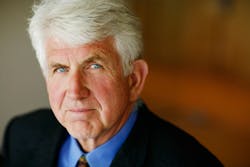Ethernet inventor Bob Metcalfe receives ACM A.M. Turing Award honors
On March 22, ACM, the Association for Computing Machinery, named Bob Metcalfe as recipient of the 2022 ACM A.M. Turing Award for the invention, standardization, and commercialization of Ethernet technology. Metcalfe is an Emeritus Professor of Electrical and Computer Engineering (ECE) at The University of Texas at Austin and a Research Affiliate in Computational Engineering at the Massachusetts Institute of Technology (MIT) Computer Science & Artificial Intelligence Laboratory (CSAIL). The ACM A.M. Turing Award, often referred to as the "Nobel Prize of Computing," carries a $1 million prize with financial support provided by Google, Inc. The award is named for Alan M. Turing, the British mathematician who articulated the mathematical foundations of computing.
As directly recounted in an ACM press release, in 1973, while a computer scientist at the Xerox Palo Alto Research Center (PARC), Metcalfe circulated a now-famous memo describing a "broadcast communication network" for connecting some of the first personal computers, PARC's Altos, within a building. The first Ethernet ran at 2.94 megabits per second, which was about 10,000 times faster than the terminal networks it would replace. Although Metcalfe's original design proposed implementing this network over coaxial cable, the memo envisioned "communication over an ether," making the design adaptable to future innovations in media technology including legacy telephone twisted pair, optical fiber, radio (Wi-Fi), and even power networks, to replace the coaxial cable as the "ether." That memo laid the groundwork for what we now know today as Ethernet.
Metcalfe's Ethernet design incorporated insights from his experience with ALOHAnet, a pioneering computer networking system developed at the University of Hawaii. Metcalfe recruited David Boggs (d. 2022), a co-inventor of Ethernet, to help build a 100-node PARC Ethernet. That first Ethernet was then replicated within Xerox to proliferate a corporate internet. In their classic 1976 Communications of the ACM article, "Ethernet: Distributed Packet Switching for Local Computer Networks," Metcalfe and Boggs described the design of Ethernet. Metcalfe then led a team that developed the 10Mbps Ethernet to form the basis of subsequent standards.
Standardization and commercialization
After leaving Xerox in 1979, Metcalfe remained the chief evangelist for Ethernet and continued to guide its development while working to ensure industry adoption of an open standard. He led an effort by Digital Equipment Corporation (DEC), Intel, and Xerox to develop a 10Mbps Ethernet specification—the DIX standard. The IEEE 802 committee was formed to establish a local area network (LAN) standard. A slight variant of DIX became the first IEEE 802.3 standard, which is still vibrant today.
As the founder of his own Silicon Valley Internet startup, 3Com Corporation, in 1979, Metcalfe bolstered the commercial appeal of Ethernet by selling network software, Ethernet transceivers, and Ethernet cards for minicomputers and workstations. When IBM introduced its personal computer (PC), 3Com introduced one of the first Ethernet interfaces for IBM PCs and their proliferating clones.
Today, Ethernet is the main conduit of wired network communications around the world, handling data rates from 10 Mbps to 400 Gbps, with 800 Gbps and 1.6 Tbps technologies emerging. Ethernet has also become an enormous market, with revenue from Ethernet switches alone exceeding $30 billion in 2021, according to the International Data Corporation.
As noted by ACM, Metcalfe insists on calling Wi-Fi by its original name, Wireless Ethernet, for old times' sake.
ACM president Yannis Ioannidis explains
"Ethernet has been the dominant way of connecting computers to other devices, to each other, and to the Internet. Metcalfe's original design ideas have enabled the bandwidth of Ethernet to grow geometrically. It is rare to see a technology scale from its origins to today's multigigabit-per-second capacity. Even with the advent of WiFi, Ethernet remains the staple mode of data communication, especially when security and reliability are prioritized. It is especially fitting to recognize such an impactful invention during its 50th anniversary year."
Metcalfe will be formally presented with the ACM A.M. Turing Award at the annual ACM Awards Banquet, which will be held this year on Saturday, June 10 at the Palace Hotel in San Francisco.
Jeff Dean, Google senior fellow and SVP of Google Research and AI, commented:
"Ethernet is the foundational technology of the Internet, which supports more than 5 billion users and enables much of modern life. Today, with an estimated 7 billion ports around the globe, Ethernet is so ubiquitous that we take it for granted. It's easy to forget that our interconnected world would not be the same if not for Bob Metcalfe's invention and his enduring vision that every computer needed to be networked."
Learn more.
For more news, projects, and profiles in the ICT cabling and connectivity sphere, subscribe to the CI&M newsletter and follow us on LinkedIn, Twitter, and Facebook.
About the Author
Cabling Installation & Maintenance Staff
Cabling Installation & Maintenance publishes news and technical information for information and communications technology (ICT) professionals.
